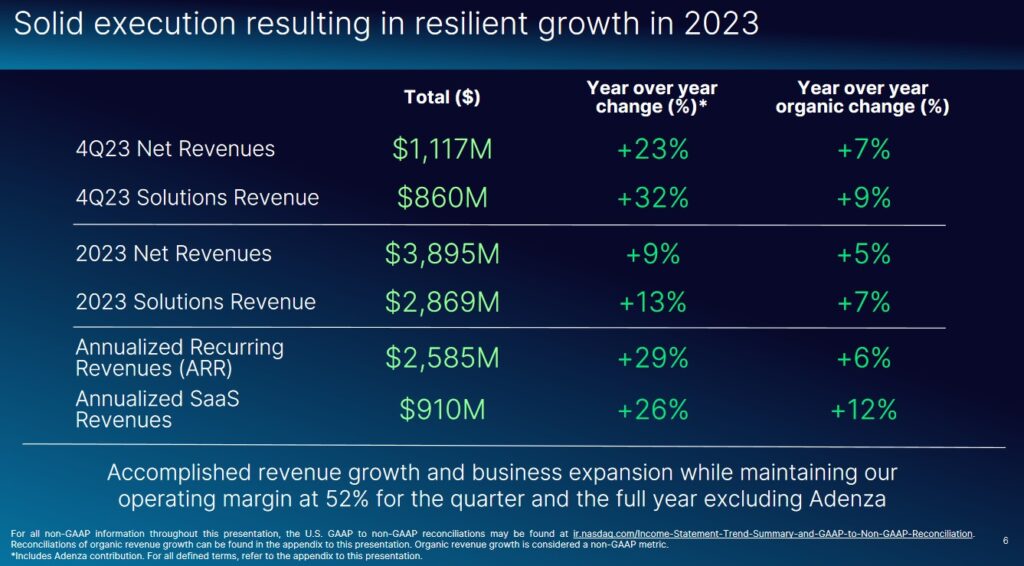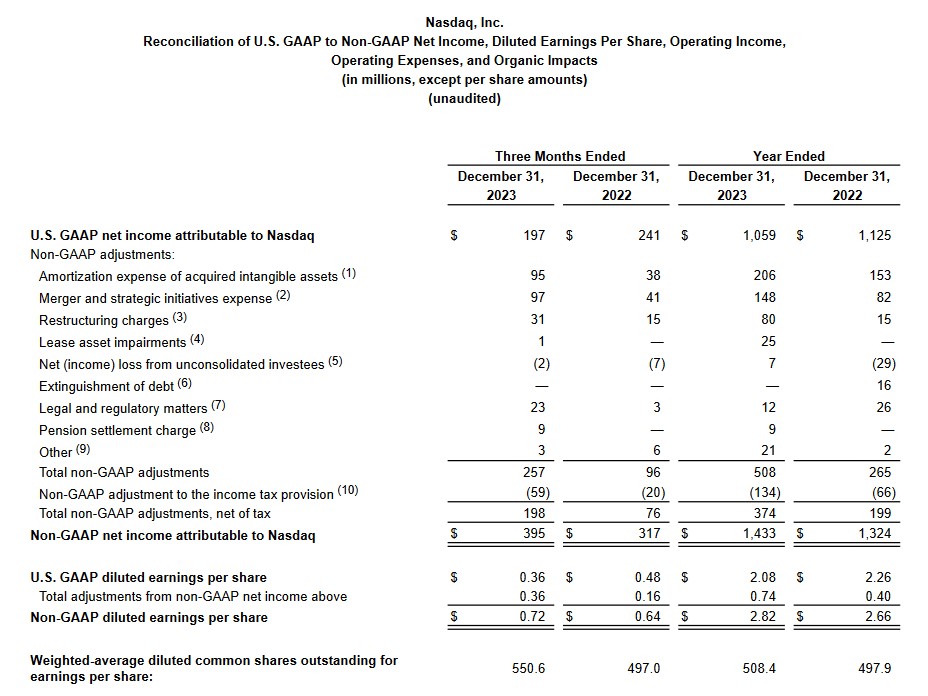Contents
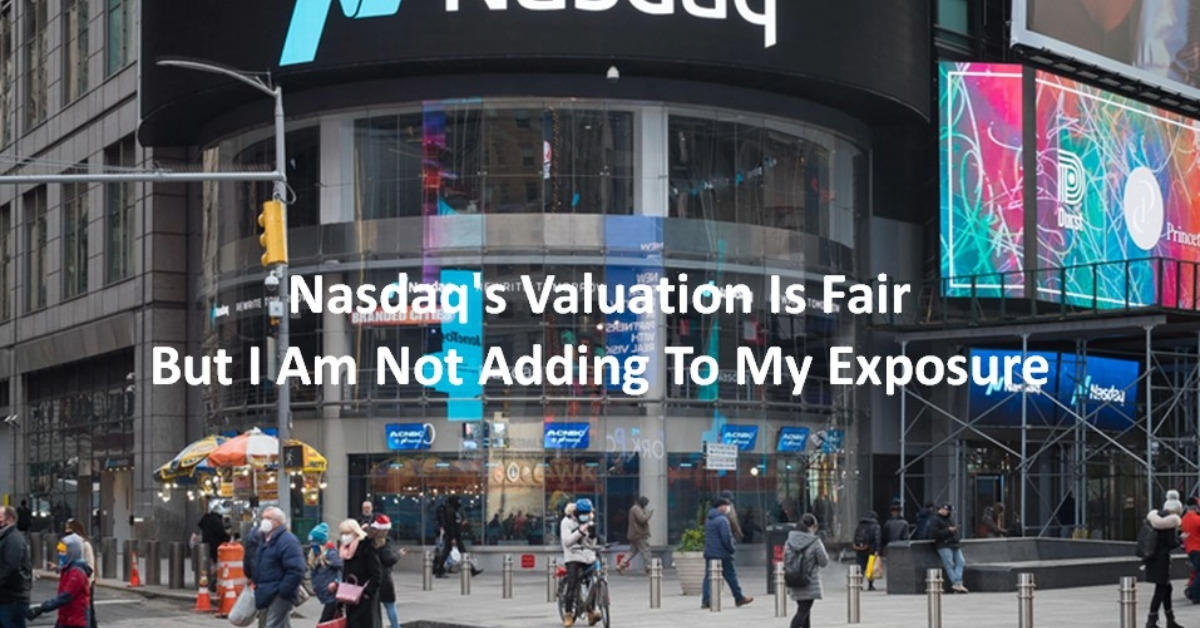
I initiated a Nasdaq (NDAQ) position with the purchase of 500 shares in a 'Core' account within the FFJ Portfolio on June 12, 2023 at ~$51/share and disclosed my rationale for doing so in this June 13, 2023 post. I subsequently acquired another 100 shares at ~$50.75 on July 19 and disclosed this purchase in this July 20, 2023 post.
My most recent review was in this October 19, 2023 post at which time NDAQ had just released Q3 and YTD2023 results.
With the release of Q4 and FY2023 results on January 31, 2024, I revisit this holding to determine if this is an opportune time to increase my exposure.
Business Overview
In September 2022, NDAQ announced a new organizational structure to align its businesses more closely with the shifts driving the evolution of the global financial system. Its new corporate structure consists of 3 business segments:
- Capital Access Platforms;
- Market Platforms, and
- Anti-Financial Crime.
An explanation of each business segment is included in NDAQ's Q3 2023 Form 10-Q commencing on page 11 of 78.
Because of the success of the Nasdaq 100 index, NDAQ is sensitive to the volatile technology sector and quarterly results can be volatile.
In an effort to reduce this volatility, NDAQ is beefing up its anti-financial-crimes business (now known as regulatory technologies). This business segment reported another good quarter with revenue increasing 17% from last year to $96 million. Strength in this anti-fraud business is helping to justify NDAQ's $2.75B purchase of Verafin in 2021; Verafin is expanding its client base to Tier 1 and Tier 2 banking clients. Management is highly confident in the growth potential of its anti-financial crime business segment and beefed up this area of business with the acquisition of Adenza in 2023 which I covered in previous posts.
Financials
Q4 and FY2023 Results
NDAQ's FY2023 Form 10-K is currently unavailable, and therefore, I reference the financial results presented in the Form 8-K issued on January 31, 2024.
Revenue generated within NDAQ's Capital Access and Market Platforms business segments is largely transactional. For example, there is a direct link between the market and the market segment's results as fee income is based on the amount of assets linked to its indexes. Due to the success of the Nasdaq 100 index, this segment is particularly sensitive to the volatile technology sector. While the market segment has delivered several quarters of double-digit quarter-over-quarter growth, this was largely driven by market forces, and sequential growth of this magnitude may well decelerate going forward.
On June 12, 2023, NDAQ announced its proposed acquisition of Adenza. At the time, NDAQ stated that 56% of its annual revenue was recurring. With the acquisition of Adenza, NDAQ's executives forecast that annual recurring revenue (ARR) would increase to 60%; 80% of Adenza's revenue was ARR with a high degree of revenue visibility (3 - 5 year client contracts with gross retention of 98%).
On November 1, NDAQ closed the Adenza acquisition so FY2023 results only reflect two months of Adenza contribution. Nevertheless, we see that NDAQ's annualized recurring revenue is showing improvement.
The following reflect NDAQ's non-GAAP financial results in FY2023 and Q4 2023.
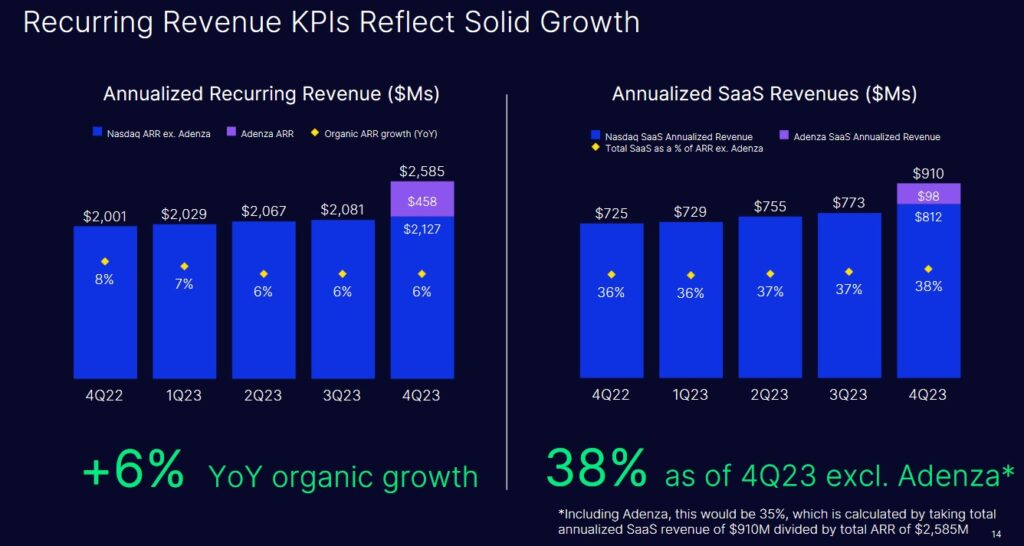
Source: NDAQ - Q4 2023 Earnings Presentation - January 31, 2024
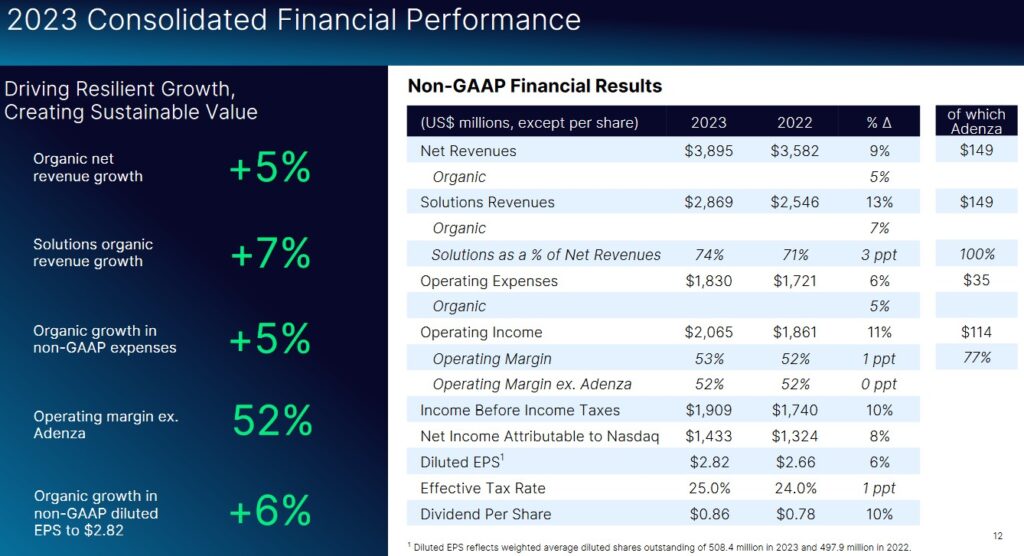
Source: NDAQ - Q4 2023 Earnings Presentation - January 31, 2024
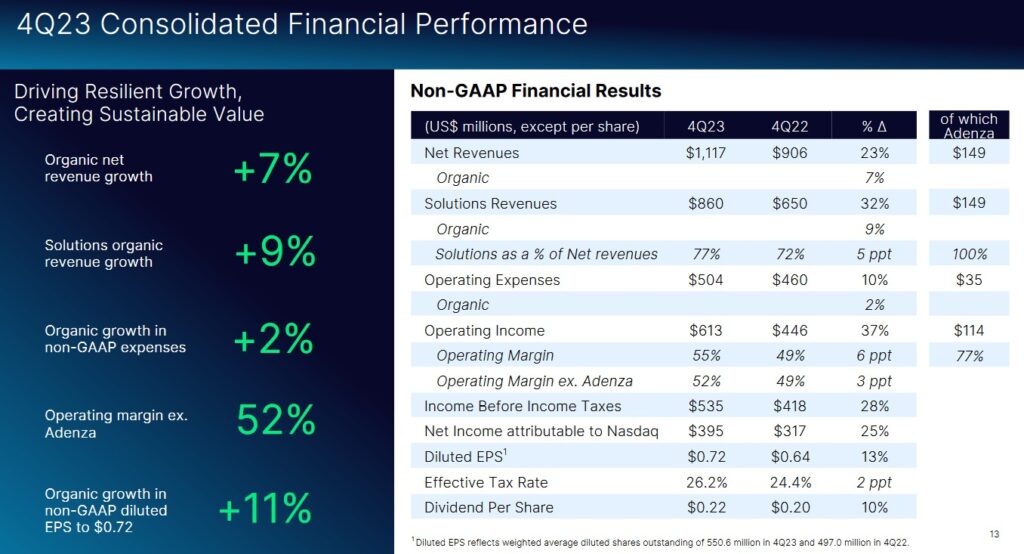
Source: NDAQ - Q4 2023 Earnings Presentation - January 31, 2024
FY2023 was a transition year. NDAQ reported lower diluted EPS relative to the corresponding period in 2022. However, NDAQ incurred several non-recurring expenses such as merger and strategic initiatives expenses, restructuring charges, lease asset impairments, and other expenses (primarily certain financing costs related to the Adenza acquisition). Such expenses are expected to be much lower in FY2024.
Free Cash Flow (FCF)
NDAQ's FCF in FY2020 - FY2023 is reflected below.
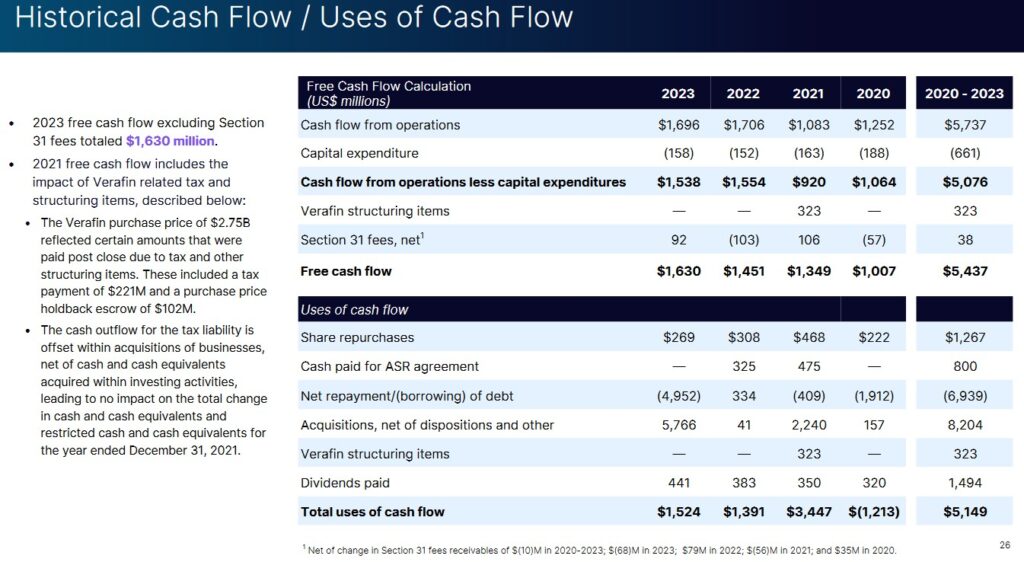
Source: NDAQ - Q4 2023 Earnings Presentation - January 31, 2024
Various investor platforms reflect NDAQ's FY2013 - FY2022 FCF as being (in millions of $) 459, 492, 594, 642, 765, 917, 836, 1,064, 920, and 1,554. In the first half of FY2023, NDAQ generated 900 of FCF and by the end of Q3, this had increased to 1,663. NDAQ, however, also calculates its FCF by taking into consideration a couple of additional items (see below).
While Adenza had $306 million in unlevered pretax free cash flow, the debt financing for the Adenza acquisition is likely to result in an annual interest payment of ~$0.325B. This exceeds Adenza’s free-cash flow. However, as Adenza grows and debt is reduced, NDAQ expects incremental FCF from the addition of Adenza to fund incremental debt repayment and share buybacks; management expects ~$0.7B in excess annual FCF beyond the dividends and employee-related buybacks. This amount is expected to grow commensurately with earnings growth over the next few years.
FY2024 Guidance
With the release of 2024 guidance, NDAQ has reiterated its objective to attain an $80 million synergy target by the end of 2025.
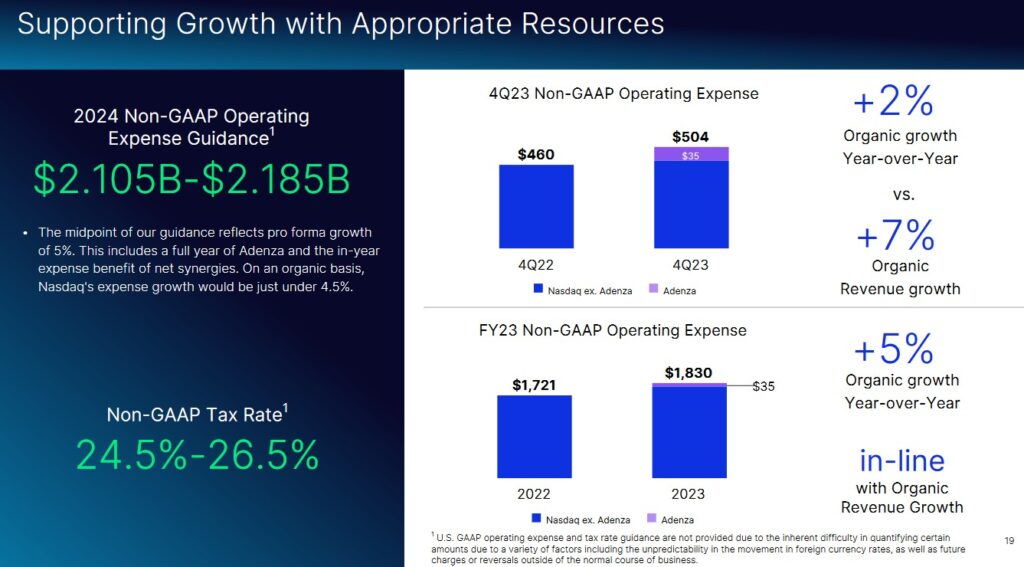
Source: NDAQ - Q4 2023 Earnings Presentation - January 31, 2024
Credit Ratings
The following reflects NDAQ's current net debt position.
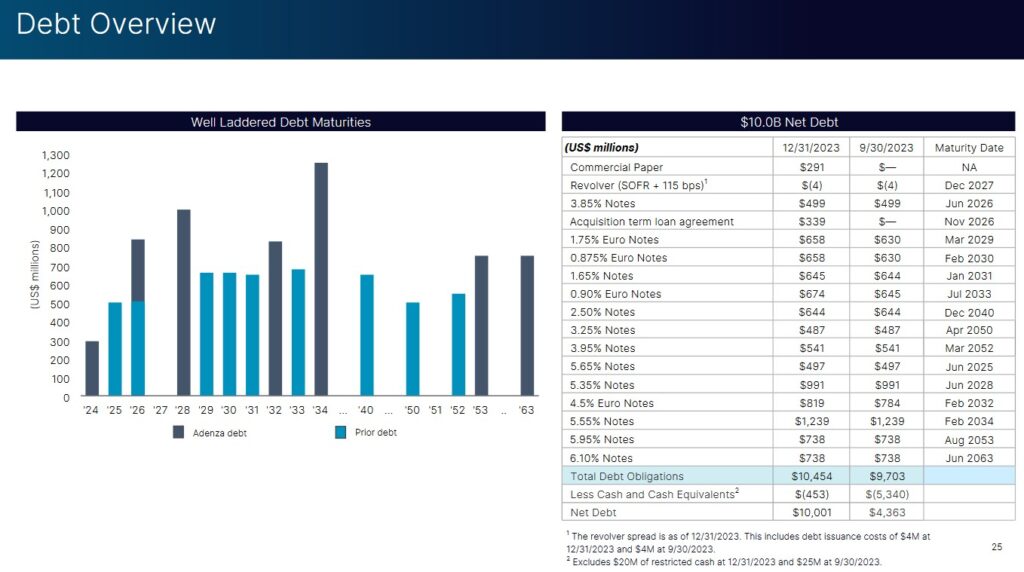
Source: NDAQ - Q4 2023 Earnings Presentation - January 31, 2024
Immediately upon announcing the Adenza acquisition, NDAQ's domestic unsecured long-term debt was downgraded from Baa1 to Baa2 by Moody's and from BBB+ to BBB by S&P Global. These new ratings are the middle tier of the lower medium grade investment grade category. They define NDAQ as having an adequate capacity to meet its financial commitments. However, adverse economic conditions or changing circumstances are more likely to lead to a weakened capacity for NDAQ to meet its financial commitments.
Despite the ratings downgrades, NDAQ has demonstrated its ability to reduce leverage within a reasonable time frame following major acquisitions. NDAQ's capital allocation priority over the next 3 years will be to reduce Gross Debt / Non-GAAP EBITDA to 4.0x in 18 months and to 3.3x in 36 months.
NDAQ expected its gross leverage ratio to be at 4.7x at the time of deal close. By FYE2023, however, this had been reduced to 4.3x.
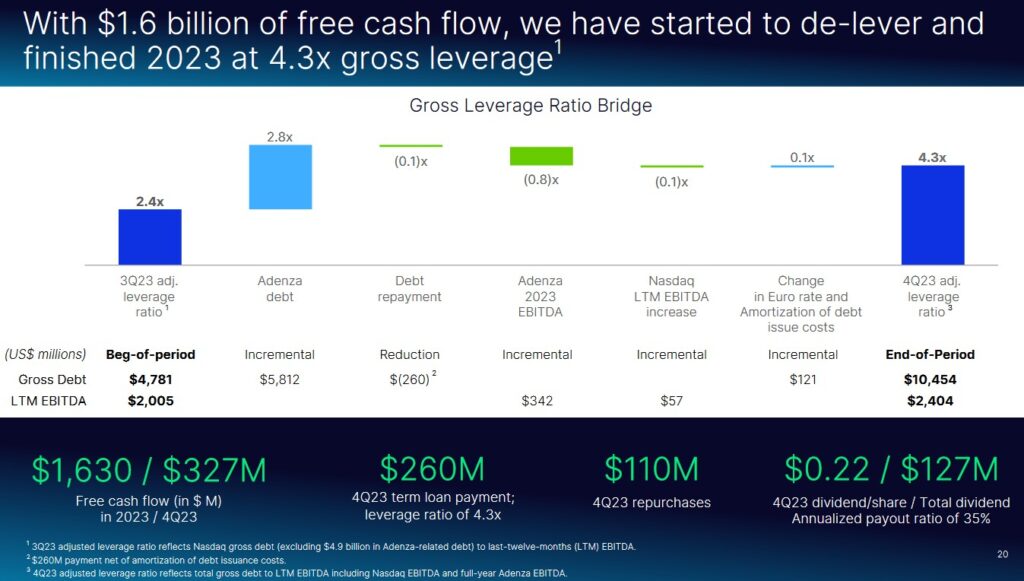
Source: NDAQ - Q4 2023 Earnings Presentation - January 31, 2024
NDAQ intends to continue to deleverage in Q1 2024.
Dividend and Dividend Yield
NDAQ's dividend history is accessible here.
On January 31, NDAQ declared its 4th consecutive $0.22/share quarterly dividend. This dividend is to be distributed on March 28 to shareholders of record at the close of business on March 13.
Since debt repayment is a top priority, I anticipate NDAQ's $0.22/share dividend may only be increased to $0.24 when the end of June 2024 dividend is declared in mid-April. Using this estimate, NDAQ's next 4 dividend distributions will total $0.94 (($0.22 x 1) + ($0.24 x 3)). Using the current ~$57 share price, the forward dividend yield is ~1.65%.
NDAQ plans to increase the dividend to achieve a 35% - 38% payout ratio over the next 3 or 4 years; this implies a ~10% CAGR in the dividend payout ratio over this timeframe. Calculation of this payout ratio annualizes the last paid quarterly dividend divided by the last 12 months of non-GAAP net income.
The weighted average number of shares outstanding in FY2013 - FY2022 (in millions of shares) is 514, 519, 514, 506, 509, 503, 501, 501, 505, and 498. The weighted average number of shares outstanding in Q4 2023 was 550.6.
The reason for the increase is because NDAQ issued 85.6 million common shares to Thoma Bravo for the Adenza purchase. NDAQ expects to partially offset deal dilution, however, with additional buybacks.
In FY2023, NDAQ repurchased $269 million of its common shares including $110 million in Q4 2023.
NDAQ plans to continue share repurchases to offset employee stock compensation.
After NDAQ's leverage reaches target levels, the vast majority of remaining FCF will be applied toward share buybacks. Management states it does not anticipate making any significant acquisition-related capital allocation decisions that would deter the company from sizable stock buybacks over the coming years.
In September 2023, NDAQ's Board approved an increase in its share repurchase authorization to a total of $2B. As of FYE2023, there was $1.9B remaining under the board authorized share repurchase program.
Stock Splits
NDAQ initiated a 3 for 1 stock split in 2022.
Valuation
In FY2013 - FY2023, NDAQ generated diluted EPS of $0.75, $0.80, $0.83, $0.21, $1.43, $0.91, $1.54, $1.86, $2.35, and $2.26. Its diluted PE levels were 20.52, 17.70, 27.31, 23.63, 49.57, 18.25, 33.89, 24.31, 30.57, and 26.91.
When I reviewed NDAQ in my July 13 post, the forward-adjusted diluted broker estimates and valuation using my ~$51 purchase price were:
- FY2023 - 14 brokers - mean of $2.72 and low/high of $2.60 - $2.84. Using the mean estimate, the forward-adjusted diluted PE is ~18.75.
- FY2024 - 15 brokers - mean of $2.89 and low/high of $2.66 - $3.11. Using the mean estimate, the forward-adjusted diluted PE is ~17.6.
- FY2025 - 8 brokers - mean of $3.06 and low/high of $3.00 - $3.15. Using the mean estimate, the forward-adjusted diluted PE is ~16.7.
Using my ~$50.75 purchase price on July 19 and the forward-adjusted diluted broker estimates, NDAQ’s valuation was:
- FY2023 – 16 brokers – mean of $2.76 and low/high of $2.60 – $2.84. Using the mean estimate, the forward-adjusted diluted PE is ~18.4.
- FY2024 – 17 brokers – mean of $2.87 and low/high of $2.29 – $3.10. Using the mean estimate, the forward-adjusted diluted PE is ~17.7.
- FY2025 – 11 brokers – mean of $3.14 and low/high of $2.97 – $3.33. Using the mean estimate, the forward-adjusted diluted PE is ~16.2.
When I wrote my September 14 guest post, NDAQ’s share price was ~$51.50. The valuation using the current forward-adjusted diluted broker estimates was:
- FY2023 – 13 brokers – mean of $2.78 and low/high of $2.60 – $2.86. Using the mean estimate, the forward-adjusted diluted PE is ~18.5.
- FY2024 – 13 brokers – mean of $2.88 and low/high of $2.50 – $3.10. Using the mean estimate, the forward-adjusted diluted PE is ~17.9.
- FY2025 – 9 brokers – mean of $3.17 and low/high of $2.99 – $3.35. Using the mean estimate, the forward-adjusted diluted PE is ~16.25.
When I wrote my October 19 post, the share price was $51.92. The valuation using the current forward-adjusted diluted broker estimates was:
- FY2023 – 15 brokers – mean of $2.78 and low/high of $2.65 – $2.83. Using the mean estimate, the forward-adjusted diluted PE is ~18.7.
- FY2024 – 15 brokers – mean of $2.89 and low/high of $2.48 – $3.10. Using the mean estimate, the forward-adjusted diluted PE is ~18.
- FY2025 – 13 brokers – mean of $3.17 and low/high of $2.96 – $3.34. Using the mean estimate, the forward-adjusted diluted PE is ~16.4.
Adenza is only expected to become accretive to NDAQ’s earnings within 2 years. Until such time, NDAQ will be incurring acquisition and integration expenses that will likely exceed incremental earnings. Given this, I lowered NDAQ’s mean FY2024 forward-adjusted diluted estimate by $0.30 to $2.59. This resulted in a forward-adjusted diluted PE ratio of ~18 based on the current ~$51.92 share price. Lowering the mean FY2025 forward-adjusted diluted estimate by $0.15 to $3.02, changes the forward-adjusted diluted PE to ~17.2.
We now know that NDAQ generated FY2023 diluted EPS and adjusted diluted EPS of $2.08 and $2.82, respectively. With shares trading at ~$57 as I compose this post, NDAQ's diluted PE is ~27.4 and its adjusted diluted PE is ~20.2.
In FY2023, it generated ~$1.630B of FCF. The weighted average number of shares outstanding for all of FY2023 was 508.4 million but surged to 550.6 million in Q4 because of the shares issued to Toma Bravo for the acquisition of Adenza. If we use 508.4 million, NDAQ generated ~$3.21 of FCF/share. If we use 550.6 million, NDAQ generated ~$2.96 of FCF/share. Rather than calculate the weighted average for FY2023, I elect to use roughly the average of these two values which is ~$3.09. With shares trading at ~$57, the P/FCF is ~18.5.
The valuation using the current ~$57.80 share price and the current forward-adjusted diluted broker estimates is:
- FY2024 – 15 brokers – mean of $2.77 and low/high of $2.59 – $3.03. Using the mean estimate, the forward-adjusted diluted PE is ~20.8.
- FY2025 – 14 brokers – mean of $3.10 and low/high of $2.93 – $3.34. Using the mean estimate, the forward-adjusted diluted PE is ~18.6.
- FY2026 – 6 brokers – mean of $3.47 and low/high of $3.27 – $3.60. Using the mean estimate, the forward-adjusted diluted PE is ~16.6.
NDAQ's primary focus is debt reduction so any shares repurchases in FY2024 will likely merely offset shares issued as part of the firm's employee compensation packages. We can, therefore, expect the weighted average shares outstanding in FY2024 to be ~550.6 million. If it is able to generate $1.7B of FCF in FY2024, the forward FCF/share should be ~$3.09 which results in a forward P/FCF value of ~18.4 when I use the current ~$57 share price.
Nasdaq's Valuation - Final Thoughts
Despite a surge in NDAQ's leverage resulting from its acquisition of Adenza, I like NDAQ's long-term strategy to accelerate its strategic vision to become a leading technology provider to the global financial system.
The valuation at the time of my purchases offered a realistic probability of attractive double-digit total investment returns over the next 5 - 10 years.
While I remain confident NDAQ can achieve these returns, I think NDAQ's current valuation is slightly less attractive than at the time of my purchases. I am not, however, adding to my exposure because I am looking to invest in great undervalued companies.
I remain cautious and am patiently waiting for a broad market pullback. Should one occur, I hope NDAQ's valuation will improve thus providing me with an opportunity to potential acquire additional shares.
I wish you much success on your journey to financial freedom!
Note: Please send any feedback, corrections, or questions to [email protected].
Disclosure: I am long NDAQ.
Disclaimer: I do not know your circumstances and do not provide individualized advice or recommendations. I encourage you to make investment decisions by conducting your research and due diligence. Consult your financial advisor about your specific situation.
I wrote this article myself and it expresses my own opinions. I do not receive compensation for it and have no business relationship with any company mentioned in this article.


